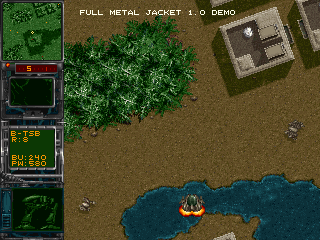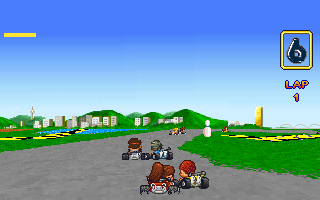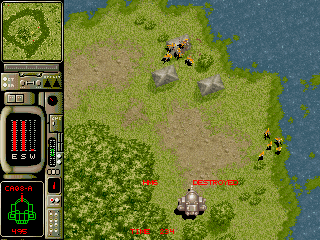A History of Korean Gaming
|
Mirinae: |
미리내 소프트웨어 Mirinae Software
미리내 엔터테인멘트 Mirinae Entertainment
Games (continued)
풀 메탈 자켓: 그 겨울의 시작 (Full Metal Jacket: Geu Gyeoul-ui Sijak) - IBM PC (February 1996)
Cover
When turning around in this 360 degrees mecha shooting game, the player's sprite stays in place and instead the entire surroundings rotate around it, similar to some arcade tank games or Super Contra's top-down levels. However, this one naturally looks much more refined than the SNES game's mode 7 graphics.
The missions are mostly rather simple, usually a number of enemies or structures has to be destroyed, before heading to an extraction point. Before every mission, the mecha has to be equipped with weapons and special modules, like timebombs or a jetpack. An English demo was available, even though the game was never released in an English speaking country. It was likely used to advertise the game to overseas publishers, which in the end didn't work out as planned.
아마게돈: 혼돈 속으로 (Armageddon: Hondon Sog-euro) - IBM PC (January 1996)
Cover
As one of the first Korean game developers Mirinae made a step towards realtime polygonal 3D graphics. Their first product that used their own Realspace 3D engine was this space shooter tie in with a contemporary big animation project. Just like Full Metal Jacket, the game features weapons management, but also a missions tree in form of a star map.
In the space flight missions, orientation can be very difficult, which is made even harder by the ugly and glutted starfield background. The flight controls are decent, but don't offer the amount of control of a Wing Commander or Conflict Freespace.
카트 레이스 (Kart Race) - IBM PC (1996)
Cover
A plain Super Mario Kart clone. 8 characters race each other for the pole position on 16 courses, what's there more to say? There's a bunch of different weapons, but it all boils down to two types with merely visual variations, being obstacles (like the Bananas in Super Mario Kart) and projectiles.
으라차차 (Eurachacha) / Eracha - IBM PC (April 27, 1996)
Korean Cover
In this cutesy platformer a little Korean troll travels around the world to save his tribe. The stations on his journey are China, Japan, Transilvania and the USA, and in every location he has to deal with local horror creatures and cultural stereotypes. Besides a club as his standard weapon, he also collects several different projectiles. And there's his secret weapon: It is possible to have the protagonist pee on the floor, which in special places leads to accelerated fungal growing. The mushrooms can then be used as trampolines to reach new heigths.
The stages are long and fairly often branched out into these secret places, while the controls and QA are also worlds better than in Apachacha. There are a few strange design decisions (why is it possible to pick up different types of ammunition when they all add up to the same pool, anyway?), but overall Eracha is a very solid and fun platformer. The game, which was developed with the help of some Makkoya employees, was also released in Germany and the UK.
폭풍 속으로 (Pokpung Sok-euro): Eden too Far / Into the Storm - IBM PC (May 10, 1996)
Cover
This vertical shooter profits from the same technical strengths as Unmyeong-ui dragontuka, but features a more elaborate weapon upgrade system.
Into the Storm in a sense marked the end of an era as the last classical 2D shoot 'em up released by Mirinae.
나무꾼 이야기 (Namukkun Iyagi) - IBM PC (May 1996)
Cover
Point and click adventures are an extraordinarily rare genre in Korea, but Namukkun Iyagi was one of the few exceptions. Presented in beautiful 640x480 pixel graphics, the game is very loosely based on a traditional fairy tale about a woodcutter and a fairy, but also mixes together other folk tales, and scenario becomes more and more crazy towards the end.
While the story is quite humorous, the puzzles leave something to be desired (the protagonist catches a tiger just by clicking on it, for example), dialogues are non-interactive cutscenes and many iffy screen exits and invisible walls make navigating around the village and the woods a chore. The string of events doesn't make much sense either, and numerous bugs can put the game in a dead-end state.
고룡전기 퍼시벌 (古龍戰記 퍼시벌 Goryong Jeon'gi Pursival) / Legend of the Ancient Dragon - IBM PC (June 1996)
Cover
After Mirinae's competent first entry into the RPG genre, this one comes as quite a surprise. Everything in it is inferior to the two years older game. The scenario is a generic medieval fantasy melange exercised a thousand times before. In fact, it holds a tad too many similarities to Record of Lodoss War. The battle system is deeply flawed, most doors in dungeons make no sense at all (when going back to the same door, the party more often than not appears in a wholly different place than before) and it has got its fair share of glitches as well.
Incomprehensibly, this game of all the Korean RPGs was chosen to be the first that got translated into English (quite badly) and released in the USA. But it wasn't enough to chose an inferior game, apparently publisher JC Research felt the need to release the game for Windows, so Mirinae shelled out an unfinished port with several new bugs, test version hotkeys intact and the common compatability issues early Windows games show on more recent machines. Worst of all, Choi Jongyeop's music, about the best part of the game, is completely missing from the Western release versions for no apparent reason (the program is even ready to play the soundtrack, it's just not on the CD). Needless to say, this carelessly crapped out release totally bombed.
배틀기어 (Battle Gear) - IBM PC (August 1996)
Advertisement
This 3D mecha game seems to bee more simulation-heavy compared to the action oriented Full Metal Jacket series, though not to the degree of most Western mecha simulations at that time.
Like in Mirinae's 2D games, each of the 19 mission begins with equipping the mecha. Only this time the process is much more elaborate, as machine is composed of individual body parts. In addition to the various weapon systems, the player can also send out foot soldiers to do certain tasks, but has to take care not to squash them. At the time of the game's release, it was hailed for its impressive technological performance, unseen in any Korean developed game before, but the enemy AI has been criticized for a flaw that makes it possible to cheat it, as it doesn't react on a player that attacks with missiles from extremely far away.
A PSX version was originally planned as well, in cooperation with a Japanese company called Infiny, a subsidiary of the Nippon Steel Corporation (Shin Nippon Seitetsu), which specialized in porting western PC games to 32-bit consoles9. Unfortunately, that project never came to fruit.
네크론 (Necrons) - IBM PC (February 1997)
Cover
Necrons was Mirinae Software's last big release before the country's long-time role model developer began to stagger.
Battles in the tactical (S)RPG in a low-fantasy eastern medieval kingdom are divided into two modes. First the overall battle is displayed on a zoomed-out map, and units are ordered around to engage into attacks on enemies or conquer castles, comparable to Ogre Battle. The encounters themselves take place on a seperate, more detailed screen, but still the player gives commands to entire regiments rather than individual soldiers.
The game is extremely hard from the very beginning, and barely even gives players time to get used to the controls before being obliterated by the enemies at least a few times.
작은 신들의 전쟁 (Jageun Sin-deul-ui Jeonjaeng) / Kid God Fighters / Super Kid - IBM PC (February 1997)
Mirinae Software's final game was a casual arena fighter. Preview screenshots showed four characters on the screen at the same time, which would make it an obscure precurser to Super Smash Brothers, but the final game only supports two players. Like most old fighting games on the PC, the controls are absolutely horrendous and the AI cheap as hell, even on the lowest difficulty setting.
It seems to have been a rather minor release after Mirinae's more ambitious 3D games, and the game has become particularly rare. JC Research was offering the game in the US10 with the title Super Kid, once again stripped of all its music. Midas published that version in Europe as well.
Artwork
칸 온라인 (Khan Online) / Khan: The Absolute Power - Windows (May 1, 2003 [open beta])
Wallpaper
After the demise of the company and its return as Mirinae Entertainment, it was decided to follow the current trend and enter the lucrative MMORPG market. Their only product, Khan Online, was somewhat derivative of established western Franchises like Ultima Online or Everquest, although spiced with typically oriental elements, as it took place in the Mongol Empire of a fantasy 13th century.
The servers were shut down on October 1, 2009.
그날이 오면 (Geu Nal-i Omyeon): Dragon Force 2 - Android (2014)
Dragon Force 2 (Android)
The first release by the new Mirinae Games continues the The Day series after a break of almost 20 years. It's title implies that it's a direct sequel of the third game, and that's also the one it looks the most similar to. The trailer showcases fast and frantic gameplay that seems faithful to the old days, however it is a free-to-play deal with in-app purchases for additional ships, pilots and extra weapons.
Unreleased Titles:
그날이 오면 (Geu Nal-i Omyeon) (1989)
남벌 (Nambeol) (1994-1997)
운명의 결전 II (Unmyeong-ui Gyeoljeon II) / Fight of Destiny 2 (1996)
그날이 오면 6 (Geu Nal-i Omyeon 6) (1996)
낚시 마당 96 (Nakksi Madang 96) (1996)
지옥의 장 (Jiok-ui Jang) / Symbol of F.AT.MA: Another Story of Ancient Dragon (1997-1998)
Multi-War (1997)
Virtual-Office (1997)
References
9. GameCom in MyCom 4/1997, page 54
10. JC Research Homepage (archive)
|
Mirinae: |




















































































































